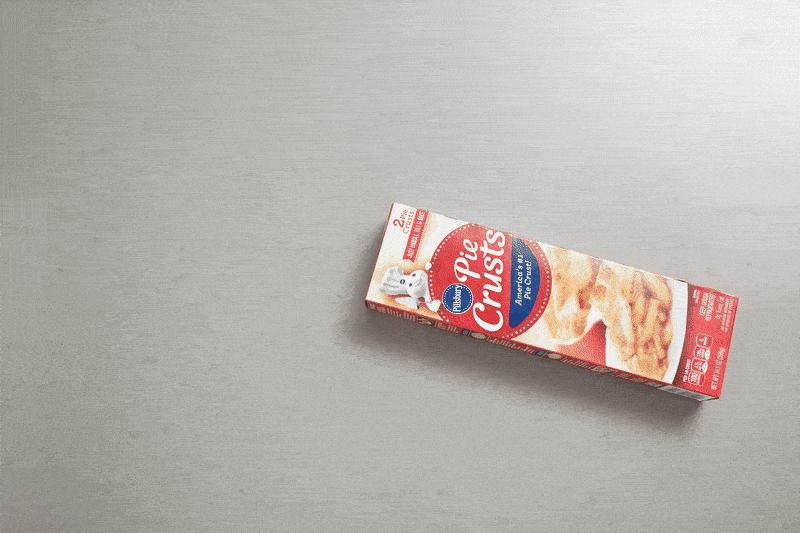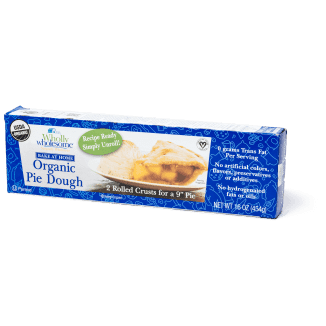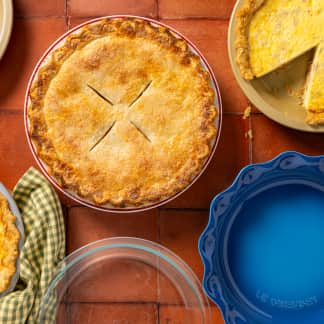Let’s get one thing out of the way immediately: Good homemade pie crust has better flavor and texture than store-bought versions. And since you can roll it into any shape and size you desire, it’s also more versatile. But sometimes you need to trade a little quality for convenience. Is there a supermarket crust that will work in a pinch?
A supermarket crust should, above all, be easy to use.
Supermarket pie crusts come in two styles: rolled crusts that you press into your own pie plate and crusts prefitted into aluminum pie plates. Experience has taught us that the supposedly convenient prefitted shells are actually a hassle—they’re too small to fit all the filling for many pies, their thin pie plates conduct heat (and thus bake) unevenly, and you have to pry one out of its pie plate and wrestle with it to form a top crust for a double-crust pie. We prefer the rolled style because we can use our own pie plate to ensure a tidy fit and even baking. Plus, rolled crusts are sold in sets of two and thus are perfect for double-crust pies. For this tasting, we focused on three nationally available rolled pie crusts, sold either refrigerated or frozen depending on the store, and tasted each in single-crust Quiche Lorraine and double-crust Make-Ahead Blueberry Pie. To really zero in on flavor and texture, we also tried the crusts plain after a short blind bake.

To our dismay, problems emerged before we even got the crusts into the oven. A supermarket crust should, above all, be easy to use, but two of the three crusts weren’t large enough to fit in our standard-size 9-inch pie plate once unrolled. We had to flour the counter and use a rolling pin to stretch them another couple of inches before they could be fitted into the pie plate, lessening the convenience of using a premade crust. Only one crust, made by Pillsbury, was large enough to use straight out of the package. What’s more, the crust made by Wholly Wholesome cracked and tore when we unrolled the dough or crimped its edges. We tried everything the company recommends to make the dough workable (thawing it overnight in the fridge, leaving it out at room temperature for 5 hours, and, after all that, microwaving it in 10-second stints), but it still cracked. The other two crusts needed only 15 to 30 minutes out of the fridge or about 1 hour out of the freezer to reach a workable texture.

On to the oven, where the Pillsbury crust was the only one to fare well. We saw this most prominently in the blueberry pie test. While the Pillsbury crust emerged tender, flaky, and evenly browned after the 11/2-hour baking time, the other two crusts started to burn about halfway through baking. One crust, by Immaculate Baking Co., began to char at the edges after 10 minutes, and we had to pull it from the oven with 40 minutes left on the timer. The Wholly Wholesome crust was evenly browned but done 20 minutes early. We kept an eagle eye on the ovens during baking and were able to salvage the pies by pulling them early, but if we had set a timer and walked away, two of the crusts would have been inedible. What gives?

According to their nutritional labels, both the Wholly Wholesome and Immaculate Baking Co. crusts contain a small amount of sugar, while the Pillsbury product has no sugar at all. Our science editor explained that excess sugar can accelerate browning by the Maillard reaction. The Wholly Wholesome crust browned quicker than our recipe time frames, but the Immaculate Baking Co. crust, which likely had a little more sugar, actually burned in both the quiche and the blueberry pie. Tasters who got past the smokiness were still displeased; many also picked up on a rancid chemical flavor in the Immaculate Baking Co. crust, even though the products we used were well within their sell-by dates. We preferred the savory richness of the Pillsbury crust, which was plenty flavorful without sugar.
The Science of Flaky Pie Crust
What makes a flaky pie crust? It comes down to the crystal structure of the fat used in the dough. Every fat has a different crystal structure that influences how it behaves when you bake with it. Some fats, including butter, lard, and shortening, have crystal structures that are orderly and compact and thus quite stable. Other fats, such as palm oil and canola oil, have crystals that are looser and less organized and are thus weaker.
The fragile crystals in less-stable fats break down at a lower temperature than the sturdier crystals in stable fats. For all fats this breakdown starts when the dough is mixed and shaped; heat from your hands or a mixer blade begins to melt the fat crystals. But because the crystals break down faster in less-stable fats, they get dispersed more, coating the flour particles and saturating the dough, which causes it to bake up dense.
The more-stable crystals found in fats such as lard and butter, by contrast, melt at a higher temperature and over a longer time, since it takes more heat to break up the dense network of tightly packed crystals. These fats remain fairly solid when the dough is shaped, forming pockets throughout. These pockets of heat-stable fat don’t melt until they hit higher oven temperatures, which creates the separate flaky layers we love in pie crust.
Texture also mattered. Pie crust should be pleasantly flaky, but again only Pillsbury hit the mark. In test after test, Pillsbury crusts baked up with crisp, airy layers of pastry, while the other two products were dense and mealy. Here, fat was the issue. Fat can be either liquid (like oil) or solid but malleable at room temperature (like butter or shortening). In the test kitchen, we use solid fats in our pie crusts because as they melt, their solid structure forms pockets that separate the dough into flaky layers. Liquid fats, on the other hand, saturate the dough, making for stiff, crumbly crusts.
We like to use a mixture of solid fats for our homemade crusts: butter for flavor and shortening for texture. But none of the premade crusts use our preferred fats. Instead, both Wholly Wholesome and Immaculate Baking Co. use palm oil (Immaculate Baking Co. also adds canola oil), while Pillsbury uses lard. Though lard and palm oil are both solid fats, the molecular structures of these fats affect texture (see “The Science of Flaky Pie Crust”). Lard is a solid fat with a very stable molecular structure similar to that of shortening, and it forms pockets of fat that melt slowly in the oven, producing tender, flaky layers of fat and flour. The fat crystals in palm oil, however, are less stable and begin to melt as the dough is prepared, coating each particle of flour and creating a crust that is heavy and dense.

The fats used in each product also explained why some crusts were easier to work with. According to food scientist Harold McGee, flaky pastry dough such as pie crust is most workable when the fat is about 15 percent to 25 percent solid. Any more and the fat is too stiff; any less and the fat oversaturates the dough, making it mealy and dense. Most fat changes from solid to liquid at a certain temperature (think about butter), but the exact temperature at which the change occurs varies depending on the type of fat.
We did some sleuthing and found that lard stays in the ideal 15 percent to 25 percent solid range at temperatures of 50 degrees to more than 75 degrees, while palm oil has a much narrower temperature window—about 60 degrees to 70 degrees. That helped explain why the Wholly Wholesome dough, which is made with all palm oil, was so tough to work with: The fat in the dough had a smaller temperature range in which it remained workable. But even at the right temperature, it still sometimes cracked—a problem that our science editor said was most likely due to too little water in the crust. We couldn’t discern the amount of water in each crust from ingredient labels, but we know from our own recipes that water can make or break a crust—too little and the dough cracks, too much and the crust gets mushy.
Pillsbury Refrigerated Pie Crusts were simple to unfurl, immediately fit in our pie plate without extra stretching, and baked up golden and flaky.
Though the Immaculate Baking Co. crust was also made using palm oil, we didn’t have as much trouble rolling it out because it also contains canola oil (a fat that is liquid at temperatures above freezing) to broaden the temperature range in which the crust can be easily rolled out. Our science editor also pointed out that the Pillsbury crust is made with “modified lard”—not the most pleasant term, but it simply means that the lard has been enhanced to stay easier to work with for an even wider temperature range.
In the end, only one product hit all our requirements for a good pie dough. Pillsbury Refrigerated Pie Crusts were simple to unfurl, immediately fit in our pie plate without extra stretching, and baked up golden and flaky. Though we still prefer homemade, when we don’t have the time, we’ll be reaching for Pillsbury.
- Bake and taste plain
- Taste in our double-crust Make-Ahead Blueberry Pie
- Taste in our single-crust Quiche Lorraine
- Taste winning crust in our single-crust Deep-Dish Apple Pie
- Ask three cooks to test each crust
- Fits in standard-size pie plate right from package
- Contains no sugar, so crust browns evenly and can withstand long baking time without scorching
- Made with lard, which makes crust flaky and easy to unroll







